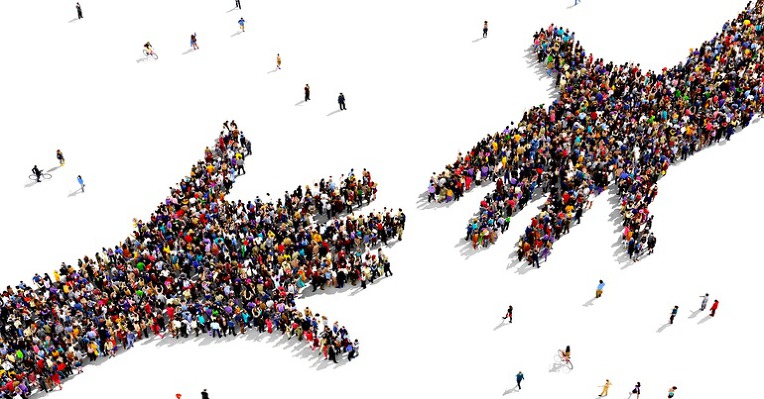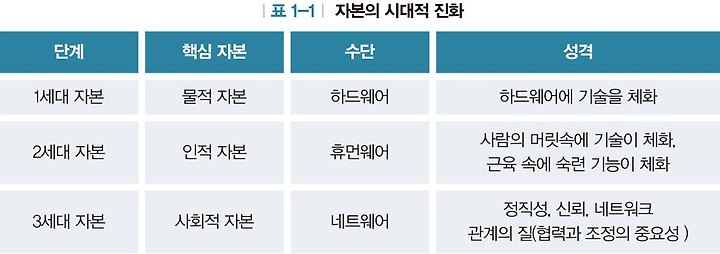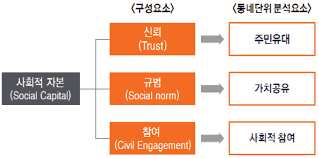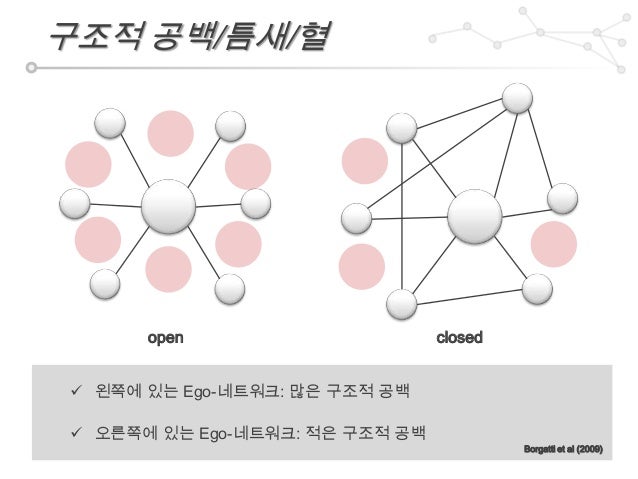List
Story > NEWS > Detail
[News] Shared Economy and Social Capital
The key factor that distinguishes a shared economy from a market economy is whether economic behavior includes social factors. Even in the market economy, social capital has a significant impact, but the shared economy itself is impossible without social capital. This is because trust and networks are key factors that enable individual-to-person sharing. Social capital has always been mentioned as a key factor in discussing a shared economy, although there is still a lack of research to analyze how social capital affects a shared economy. Social capital is the tangible and intangible capital that an individual can take based on relationships among people, which has been treated as trust, network, and reciprocal in previous studies.

In social studies, which have consistently emphasized social relations, the content of social capital is not new, but it is relatively recent that it has systematically organized the concept of social capital and started to be subject to research. Social capital began to be used in earnest for research, starting with Bourdieu and Coleman. Bourdieu analyzed capital by dividing it into business capital, cultural capital and social capital. Of these, social capital is defined as "the sum of real or potential resources that can be obtained by being part of a particular group or by being acquainted with each other or institutionalized relationships of recognition Bourdieu, who approached social capital from a Marxist perspective, saw that all capital could ultimately be converted into economic capital, and based on this view, social capital or cultural capital would be converted into economic capital and inequality would be reproduced.
On the other hand, Coleman, who studied social capital at a similar time, defines social capital through the distinction between material and human capital. According to his explanation, material capital is an entity made in observable material form, and human capital is a skill or knowledge acquired by an individual. Apart from these two capital, social capital refers to the relationship that individuals have in them, especially trust. The form and function of social capital presented by Coleman can be divided into three.

First of all, the first function of social capital is the duty and expectation that people have for each other, so that people can get the effect of reducing transaction costs. The system can be cited as a case in point. The second function is the potential access to information that pervades social relationships. In other words, the social relationships that make up the social capital provide information about specific actions, such as trends and accidents. Thirdly, social capital appears in the form of norms or effective sanctions. If a norm exists and it is effective, a strong social capital is formed. The three functions presented by Coleman are linked to the task of categorizing social capital in order to use it for specific analysis. The first type is trust. If a person who has a social relationship with an individual helps to do something that he or she cannot do alone, the individual will have some kind of social debt to the person who has helped. If society as a whole has expectations of paying off these social debts, it acts as a social capital within society as a trust. This type can be seen better in closed traditional society rather than in relatively modern society, because the closeness raises the expectation that social obligatory relations will be kept. The second type is the network. The distribution of information that arises within a social relationship allows individuals to have information quickly that they cannot have on their own. Individuals have a tendency to maximize information acquisition through social relationships. The importance of information acquired through social networks is growing in the information society where information is pouring out.

The third is norms and effective sanctions. This is the social capital for which trust and networks are formed, maintained and developed. In traditional society, there were norms that could be rewarded with honor, status, etc. as a result of such pursuit, pursuing social interests rather than personal interests. In modern society, a fair system that suppresses opportunistic behavior can be called social capital of this type. Related studies include Talkville, Putnam and Lumen, who understand as a dimension of social structure that cannot be returned to the psychological or institutional level. It is difficult to include norms and sanctions in the study unless the scope of a particular community is established in the sense that social capital is constructed at the social level. Therefore, it is not easy to include norms and sanctions as social capital variables in the process of uncovering factors that affect the willingness to participate in a shared economy comprehensively on a personal level.

The degree of people-to-people bond is determined by the time they devote themselves to relationships, the intensity of their emotions, closeness, and mutual services. Often weak ties were judged to be socially useless, but they work as a powerful social capital on the side of information distribution. Those linked to strong ties form a relatively closed cluster, so information stays within it only, while those with weak ties distribute ideas, influences and information more quickly and efficiently because the information does not circulate inside. Bert believed that structural holes mediated the distribution of information between groups of people. In other words, information is distributed through people connecting two sets of non-redundant groups, and this structural vacuum is an opportunity to broker the flow of information between people and to control people in different clusters.
The key factor that distinguishes a shared economy from a market economy is whether economic behavior includes social factors. Even in the market economy, social capital has a significant impact, but the shared economy itself is impossible without social capital. This is because trust and networks are key factors that enable individual-to-person sharing. Social capital has always been mentioned as a key factor in discussing a shared economy, although there is still a lack of research to analyze how social capital affects a shared economy. Social capital is the tangible and intangible capital that an individual can take based on relationships among people, which has been treated as trust, network, and reciprocal in previous studies.

In social studies, which have consistently emphasized social relations, the content of social capital is not new, but it is relatively recent that it has systematically organized the concept of social capital and started to be subject to research. Social capital began to be used in earnest for research, starting with Bourdieu and Coleman. Bourdieu analyzed capital by dividing it into business capital, cultural capital and social capital. Of these, social capital is defined as "the sum of real or potential resources that can be obtained by being part of a particular group or by being acquainted with each other or institutionalized relationships of recognition Bourdieu, who approached social capital from a Marxist perspective, saw that all capital could ultimately be converted into economic capital, and based on this view, social capital or cultural capital would be converted into economic capital and inequality would be reproduced.
On the other hand, Coleman, who studied social capital at a similar time, defines social capital through the distinction between material and human capital. According to his explanation, material capital is an entity made in observable material form, and human capital is a skill or knowledge acquired by an individual. Apart from these two capital, social capital refers to the relationship that individuals have in them, especially trust. The form and function of social capital presented by Coleman can be divided into three.

First of all, the first function of social capital is the duty and expectation that people have for each other, so that people can get the effect of reducing transaction costs. The system can be cited as a case in point. The second function is the potential access to information that pervades social relationships. In other words, the social relationships that make up the social capital provide information about specific actions, such as trends and accidents. Thirdly, social capital appears in the form of norms or effective sanctions. If a norm exists and it is effective, a strong social capital is formed. The three functions presented by Coleman are linked to the task of categorizing social capital in order to use it for specific analysis. The first type is trust. If a person who has a social relationship with an individual helps to do something that he or she cannot do alone, the individual will have some kind of social debt to the person who has helped. If society as a whole has expectations of paying off these social debts, it acts as a social capital within society as a trust. This type can be seen better in closed traditional society rather than in relatively modern society, because the closeness raises the expectation that social obligatory relations will be kept. The second type is the network. The distribution of information that arises within a social relationship allows individuals to have information quickly that they cannot have on their own. Individuals have a tendency to maximize information acquisition through social relationships. The importance of information acquired through social networks is growing in the information society where information is pouring out.

The third is norms and effective sanctions. This is the social capital for which trust and networks are formed, maintained and developed. In traditional society, there were norms that could be rewarded with honor, status, etc. as a result of such pursuit, pursuing social interests rather than personal interests. In modern society, a fair system that suppresses opportunistic behavior can be called social capital of this type. Related studies include Talkville, Putnam and Lumen, who understand as a dimension of social structure that cannot be returned to the psychological or institutional level. It is difficult to include norms and sanctions in the study unless the scope of a particular community is established in the sense that social capital is constructed at the social level. Therefore, it is not easy to include norms and sanctions as social capital variables in the process of uncovering factors that affect the willingness to participate in a shared economy comprehensively on a personal level.

The degree of people-to-people bond is determined by the time they devote themselves to relationships, the intensity of their emotions, closeness, and mutual services. Often weak ties were judged to be socially useless, but they work as a powerful social capital on the side of information distribution. Those linked to strong ties form a relatively closed cluster, so information stays within it only, while those with weak ties distribute ideas, influences and information more quickly and efficiently because the information does not circulate inside. Bert believed that structural holes mediated the distribution of information between groups of people. In other words, information is distributed through people connecting two sets of non-redundant groups, and this structural vacuum is an opportunity to broker the flow of information between people and to control people in different clusters.



